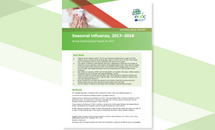Seasonal influenza - Annual Epidemiological Report for 2017 - 2018
During the 2017–2018 season, 41 315 specimens from sentinel primary care providers were tested for influenza, 22% more than in the previous season; 49% of the specimens were positive for influenza virus (previous season: 40%).
Executive summary
Influenza activity started in week 47/2017 and returned to baseline levels in week 18/2018.
In northern and south-western Europe (EU/EEA) , the activity started to increase between mid-December and early January, similar to the timing of the 2016–2017 season but earlier than in the previous five seasons.
The peak in activity was in early January in south-western Europe and in mid-February 2018 in northern Europe (EU/EEA). In some countries in Eastern Europe, influenza activity did not peak until mid- to late March.
The majority of influenza viruses detected were of type B, representing a higher level of circulation of influenza B viruses compared to recent seasons. Of all subtyped influenza B viruses detected in sentinel samples, 97% were B/Yamagata and 3% were B/Victoria viruses. Both influenza A subtypes, A(H3N2) and A(H1N1)pdm09 co-circulated in the region. Of all subtyped A viruses detected in sentinel samples, 38% were A(H3N2) viruses and 62% were A(H1N1)pdm09 viruses.
Influenza viruses circulated at high levels between weeks 51/2017 and 13/2018. This is longer than in recent seasons and may have contributed to the high severity of the 2017/18 season. Especially influenza B activity was detected for a longer period of the season and at a greater magnitude than in the previous seasons. Severe cases were observed in hospital settings due to B virus, but also due to A(H3N2) and A(H1N1)pdm09 viruses. Overall, the majority of severe cases were due to influenza virus type B infection and mostly were persons 40 years of age or older. Patients in intensive care units were mostly infected by influenza type A virus.
Overall, excess mortality from all causes was reported by the majority of 21 reporting countries during the influenza season and was mainly observed in people aged 65 years or older.
Download

Read more on the ECDC website
Infographic: Influenza in Europe, Season 2017-2018
Influenza in Europe, summary of the season 2017–18
The influenza 2017/18 surveillance season started in week 40/2017 & ended in week 20/2018. Here you find an overview of the ECDC main outputs during the season 2017/18.
Annual epidemiological reports on seasonal influenza
This disease surveillance report presents an overview of the epidemiological situation for communicable diseases and related health issues that are under European Union (EU) and European Economic Area (EEA) surveillance.
More about influenza surveillance
Flu News Europe: Weekly influenza updates
Weekly reports on influenza activity in Europe throughout the flu season are available as Flu News Europe reports and weekly infographic.
Influenza Virus Characterisation Reports, summary Europe
The influenza virus characterisation reports give an overview of circulating influenza viruses in Europe. They provide details on the current vaccine strains, summarise the development of the viruses since the last report, and closely follow the main developments for the ongoing influenza season.
Influenza season summaries
In the Influenza season summaries you find the ECDC main outputs during the influenza season as well as an Infographic showing a summary of the season.
National and global influenza surveillance systems and reports
List of external links to national and global influenza surveillance systems and reports.




